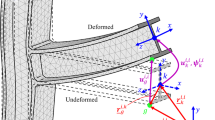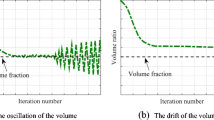Abstract
Existing multibody system (MBS) algorithms treat articulated system components that are not rigidly connected as separate bodies connected by joints that are governed by nonlinear algebraic equations. As a consequence, these MBS algorithms lead to a highly nonlinear system of coupled differential and algebraic equations. Existing finite element (FE) algorithms, on the other hand, do not lead to a constant mesh inertia matrix in the case of arbitrarily large relative rigid body rotations. In this paper, new FE/MBS meshes that employ linear connectivity conditions and allow for arbitrarily large rigid body displacements between the finite elements are introduced. The large displacement FE absolute nodal coordinate formulation (ANCF) is used to obtain linear element connectivity conditions in the case of large relative rotations between the finite elements of a mesh. It is shown in this paper that a linear formulation of pin (revolute) joints that allow for finite relative rotations between two elements connected by the joint can be systematically obtained using ANCF finite elements. The algebraic joint constraint equations, which can be introduced at a preprocessing stage to efficiently eliminate redundant position coordinates, allow for deformation modes at the pin joint definition point, and therefore, this new joint formulation can be considered as a generalization of the pin joint formulation used in rigid MBS analysis. The new pin joint deformation modes that are the result of C 0 continuity conditions, allow for the calculations of the pin joint strains which can be discontinuous as the result of the finite relative rotation between the elements. This type of discontinuity is referred to in this paper as nonstructural discontinuity in order to distinguish it from the case of structural discontinuity in which the elements are rigidly connected. Because ANCF finite elements lead to a constant mass matrix, an identity generalized mass matrix can be obtained for the FE mesh despite the fact that the finite elements of the mesh are not rigidly connected. The relationship between the nonrational ANCF finite elements and the B-spline representation is used to shed light on the potential of using ANCF as the basis for the integration of computer aided design and analysis (I-CAD-A). When cubic interpolation is used in the FE/ANCF representation, C 0 continuity is equivalent to a knot multiplicity of three when computational geometry methods such as B-splines are used. C 2 ANCF models which ensure the continuity of the curvature and correspond to B-spline knot multiplicity of one can also be obtained. Nonetheless, B-spline and NURBS representations cannot be used to effectively model T-junctions that can be systematically modeled using ANCF finite elements which employ gradient coordinates that can be conveniently used to define element orientations in the reference configuration. Numerical results are presented in order to demonstrate the use of the new formulation in developing new chain models.
Similar content being viewed by others
References
Abbas, L.K., Rui, X., Hammoudi, Z.S.: Plate/shell element of variable thickness based on the absolute nodal coordinate formulation, Part K. IMechE J. Multibody Dyn. 224, 127–141 (2010)
Dmitrochenko, O.N., Pogorelov, D.Y.: Generalization of plate finite elements for absolute nodal coordinate formulation. Multibody Syst. Dyn. 10(1), 17–43 (2003)
Dufva, K.E., Sopanen, J.T., Mikkola, A.M.: A two-dimensional shear deformable beam element based on the absolute nodal coordinate formulation. J. Sound Vib. 280, 719–738 (2005)
Garcia-Vallejo, D., Escalona, J.L., Mayo, J., Dominguez, J.: Describing rigid-flexible multibody systems using absolute coordinates. Nonlinear Dyn. 34, 75–94 (2003)
Garcia-Vallejo, D., Mayo, J., Escalona, J.L.: Three-dimensional formulation of rigid-flexible multibody systems with flexible beam elements. Multibody Syst. Dyn. 20(1), 1–28 (2008)
Hussein, B.A., Weed, D., Shabana, A.A.: Clamped end conditions and cross section deformation in the finite element absolute nodal coordinate formulation. Multibody Syst. Dyn. (2009). doi:10.1007/s11044-009-9146-6
Kerkkänen, K.S., García-Vallejo, D., Mikkola, A.M.: Modeling of belt-drives using a large deformation finite element formulation. Nonlinear Dyn. 43, 239–256 (2006)
Ogden, R.W.: Non-linear Elastic Deformations. Dover, New York (1984)
Lan, P., Shabana, A.A.: Integration of B-spline geometry and ANCF finite element analysis. Nonlinear Dyn. (2010). doi:10.1007/s11071-009-9641-6
Piegl, L., Tiller, W.: The NURBS Book, 2nd edn. Springer, New York (1997)
Roberson, R.E., Schwertassek, R.: Dynamics of Multibody Systems. Springer, Berlin (1988)
Sanborn, G.G., Shabana, A.A.: On the integration of computer aided design and analysis using the finite element absolute nodal coordinate formulation. Multibody Syst. Dyn. 22, 181–197 (2009)
Schiehlen, W.O.: Multibody system dynamics: roots and perspectives. Multibody Syst. Dyn. 1, 149–188 (1997)
Schwab, A.L., Meijaard, J.P.: Comparison of three-dimensional flexible beam elements for dynamic analysis: classical finite element formulation and absolute nodal coordinate formulation. J. Comput. Nonlinear Dyn. 5(1), 011010-1–011010-10 (2010)
Shabana, A.A.: Computer implementation of the absolute nodal coordinate formulation for flexible multibody dynamics. Nonlinear Dyn. 16, 293–306 (1998)
Shabana, A.A.: Computational Continuum Mechanics. Cambridge University Press, Cambridge (2008)
Shabana, A.A.: General method for modeling slope discontinuities and T-sections using ANCF gradient deficient finite elements. ASME J. Comput. Nonlinear Dyn. (2010, in press)
Shabana, A.A., Mikkola, A.M.: Use of the finite element absolute nodal coordinate formulation in modeling slope discontinuity. ASME J. Mech. Des. 125(2), 342–350 (2003)
Shabana, A.A., Wehage, R.A.: Spatial transient analysis of inertia-variant flexible mechanical systems. ASME J. Mech. Transm. Autom. Des. 106, 172–178 (1984)
Tian, Q., Chen, L.P., Zhang, Y.Q., Yang, J.Z.: An efficient hybrid method for multibody dynamics simulation based on absolute nodal coordinate formulation. ASME J. Comput. Nonlinear Dyn. 4, 021009-1–021009-14 (2009)
Tian, Q., Zhang, Y., Chen, L., Yang, J.: Simulation of planar flexible multibody systems with clearance and lubricated revolute joints. Nonlinear Dyn. 60, 489–511 (2010)
Yakoub, R.Y., Shabana, A.A.: Three dimensional absolute nodal coordinate formulation for beam elements: implementation and application. ASME J. Mech. Des. 123, 614–621 (2001)
Yoo, W.S., Lee, J.H., Park, S.J., Sohn, J.H., Pogorelov, D., Dimitrochenko, O.: Large deflection analysis of a thin plate: computer simulation and experiment. Multibody Syst. Dyn. 11, 185–208 (2004)
Author information
Authors and Affiliations
Corresponding author
Rights and permissions
About this article
Cite this article
Hamed, A.M., Shabana, A.A., Jayakumar, P. et al. Nonstructural geometric discontinuities in finite element/multibody system analysis. Nonlinear Dyn 66, 809–824 (2011). https://doi.org/10.1007/s11071-011-9953-1
Received:
Accepted:
Published:
Issue Date:
DOI: https://doi.org/10.1007/s11071-011-9953-1




